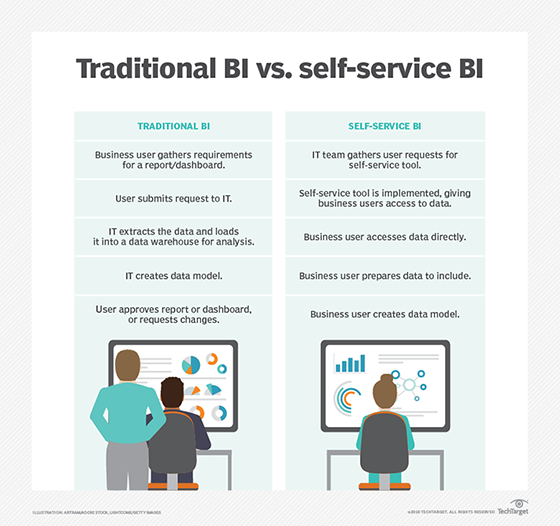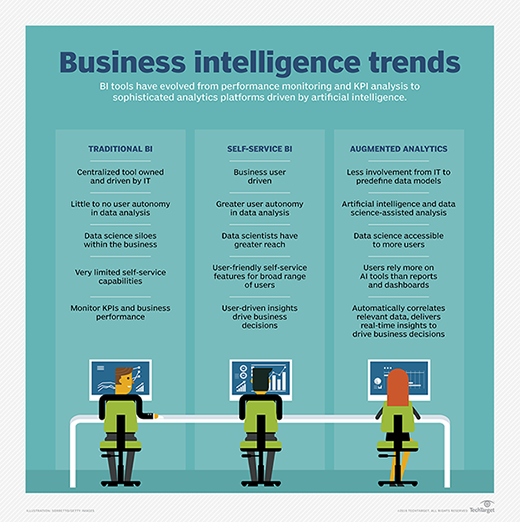What is self-service business intelligence (self-service BI)?
Self-service business intelligence (BI) is an approach to data analytics that enables nontechnical business users to access and explore data sets. These tools work even if users don't have a background in BI or related functions such as data mining, statistical analysis and data science. Self-service BI tools let users filter, sort, analyze and visualize data points without involving an organization's BI teams and IT departments.
Self-service BI capabilities make it easier for employees -- from executives to frontline workers -- to get useful business insights from the data collected in BI systems. The primary goal is to drive more informed and data-centered decision-making that results in positive business outcomes, such as increased efficiency, better customer satisfaction and increased revenue and profits.
It doesn't take a lot of technical know-how to work with these data analytics tools, but it does require the user have the business knowledge and experience to know what questions to ask. They also must know how to act on the answers, and, perhaps most importantly, what questions to ask next.
What's the difference between self-service BI and traditional BI?
With traditional BI tools and processes, the BI team or IT does the data analysis work for business users. In this approach, users request new analytical queries, which a BI analyst or other BI professional writes and runs for them. Similarly, users ask for new reports and BI dashboards, typically through a requirements-gathering process initiated by BI staffers.
This article is part of
Ultimate guide to business intelligence in the enterprise
Once a project is approved -- which can take weeks in some cases -- the BI team prepares the required data. That might mean working with IT to extract it from source systems, transform and cleanse it, and load it into a data warehouse or other data store. The BI team then creates queries to produce the requested analytics results and designs a dashboard or report to display the information.
Conversely, a self-service BI environment enables business analysts, data scientists, executives and other users to run queries themselves and create their own data visualizations, dashboards and reports. Because some of those users might not be tech savvy, it's imperative that the user interface (UI) in self-service analytics software be intuitive and easy to use. But self-service BI systems should meet the needs of both casual users, who only want to view data, and power users with more technical skills who want more information.
Training is needed to help self-service users understand what data is available and how it can be queried and used to make data-driven business decisions. In many cases, the members of the BI team also support users as needed on an ongoing basis and promote BI best practices throughout the organization.

What are the benefits of self-service BI?
The expanded data access and analytics capabilities that self-service BI provides can benefit businesses in a variety of ways. The specific benefits include the following:
- Better use of BI and IT resources. Because business users can do their own ad hoc analysis, self-service BI frees BI and IT teams from having to create queries, visualizations, dashboards and reports. They can focus on higher-value priorities and tasks that require more technical skills, such as curating data sets for business users and creating complex queries.
- Faster data analysis and decision-making. When organizations use self-service tools to shift analytics tasks to business users and away from the few BI professionals they employ, they eliminate bottlenecks in BI processes. That in turn accelerates business processes, because users can more quickly analyze data, make decisions and take actions. Some self-service BI tools also increase the amount of data gathered for an organization.
- A data-driven organization. As more business executives, managers and workers use BI tools, self-service systems create a fully data-driven culture in both the C-suite and business operations. It's important to understand from the start that this entails culture change within the enterprise. Employees and managers must embrace the opportunities self-service business intelligence and data analytics provide, learn to use the new resources and make it part of their day-to-day thinking. Such a culture change can ensure that data is at the center of informed decision-making.
- A single source of truth. In many organizations, do-it-yourself data analysis leads to spreadsheet wars, with many answers to the same or similar questions and no clear way to determine which is right. A well-structured self-service BI environment unifies vetted source data and offers standards for analysis that can be embraced by all. It also provides the self-service BI tools for analyzing the data, leading to more cohesive results.
- Competitive advantages. The expanded use of data and accelerated decision-making makes an organization more agile, which helps it create or maintain a competitive edge in the marketplace. This is particularly true if it makes more substantial use of self-service tools than its business rivals.
What are the challenges of self-service BI?
Self-service BI deployments also pose various challenges for organizations. The hurdles and roadblocks to a successful self-service initiative include the following:
- Lack of adoption by business users. Like traditional BI environments, business executives and managers can be slow to adopt self-service tools. They might want to continue to base decisions on their own knowledge and intuition. Self-service BI applications that don't have user-friendly interfaces may also see less user adoption.
- Inaccurate analytics results. Self-service queries can produce bad results because of incomplete data sets or data errors that aren't identified and fixed. There's also a risk of inconsistent information if separate users work with different versions of the same data or filter and prepare it for analysis in different ways. These issues can lead to confusion over BI findings and, ultimately, faulty decision-making.
- Data security, privacy and ethics issues. The expanded data access that self-service BI provides can cause problems if strong data security protections and an effective data governance policy aren't put in place. For example, unauthorized users could access sensitive data, or data could be misused in ways that violate data privacy regulations and company ethics standards.
- Uncontrolled deployments. Self-service BI environments can become chaotic without the BI team providing some level of centralized monitoring and oversight. If business units deploy BI systems on their own, inconsistent data silos, multiple BI tools and runaway costs can make it hard to scale self-service capabilities effectively and efficiently.
To avoid or overcome such challenges, an organization must start with a well-planned BI strategy, including a solid BI architecture that establishes technology and governance standards. Those foundational elements can ensure that the organization has the right data sets and the infrastructure to support enterprise-wide use of self-service BI tools.
Additionally, a BI training program should educate workers on how to use self-service systems, and also on how to find the business data they need and create effective data visualizations, dashboards and reports. Meanwhile, the data governance policy should define key data quality metrics; data management, access and use policies; procedures for sharing reports and dashboards; and how data security and privacy protections will be maintained.
Examples of self-service BI tools
Qlik, Tableau (now part of Salesforce) and Tibco were among the first vendors of self-service BI and data visualization tools. Now, software vendors that once offered traditional BI tools for skilled data analysts also provide self-service products. Modern analytics and BI platforms are easy-to-use tools that support the full data analysis workflow with an emphasis on self-service capabilities and augmented analytics features designed to help users find, prepare and analyze data.
Top self-service BI platform providers identified in recent TechTarget research include Amazon Web Services, Domo, Google, Microsoft, MicroStrategy, Pyramid Analytics, Qlik, Salesforce, Tellius and ThoughtSpot.
Ease of use, sophistication and features differ for each vendor's self-service BI tools. For example, some platforms are primarily used for simple dashboards and visualizations rather than more complicated data analysis and associated tasks, such as self-service data preparation, data discovery and interactive visual exploration.
Common features of self-service BI tools
Self-service BI software's core features include ad hoc query, data visualization, dashboard design and report generation capabilities. Executives and operations personnel can use the software as a simple self-service reporting tool to see specific information. More advanced users can take advantage of querying and design features to share analytics results with others.
Self-service tools offer various other features, either as standard items or optional add-ons. These include the following:
- Connections to different and new data sources for accessing relevant data.
- Data sharing and collaboration features.
- Data modeling and curation capabilities.
- Support for running BI apps on mobile devices.
- Data storytelling tools for creating narrative presentations.
- Mapping and geospatial data functionality.
- Data preparation and data catalog software.
- Predictive modeling for what-if analysis of different scenarios.
What to look for in a self-service BI tool
When selecting a self-service BI tool, organizations must evaluate several factors to ensure the chosen approach aligns with their needs and goals. The following are the most important factors:
- Ease of use and UI. The primary consideration when selecting a self-service BI tool is a simple user experience. It should be intuitive, letting users of all capabilities make use of its features. The best tools have drag-and-drop, reporting and visualization functionalities. A user-friendly interface should adequately meet the requirements of both nontechnical users who only want to view data as well as users with more technical skills.
- Data connectivity and integration. A self-service BI tool should be able to connect with various data sources, including data center and cloud databases as well as third-party applications. Additionally, the tool should support advanced data integration features and provide metadata for each data source, enhancing its resourcefulness.
- Scalability and performance. As data volumes and user numbers grow, the platform must scale to deliver consistent optimal performance. Organizations need to ensure that the amount of data the tool can handle and the number of users it can support will meet their needs. They also must consider any requirements they have for real-time analysis and faster decisions. Large enterprises should pay attention to scale-out options.
- Security and governance. Security is paramount when dealing with sensitive business data. The BI tool must include features to prevent data breaches and support privacy compliance processes; those include access and authentication capabilities, as well as data encryption. The tool should support a data governance framework to prevent the proliferation of nonstrategic content and allow for the delegation of security administration to specific user groups within each department.
- Analytics. Organizations should look for self-service BI with predictive modeling, artificial intelligence (AI) and other advanced analytical capabilities. The tool should let users create, modify and manipulate business logic or calculations using advanced features.
- Collaboration and sharing. Effective self-service BI tools should facilitate collaboration among users. Organizations should look for features that let data be shared and reused in different content formats with external members. The tool should support call-to-action functionalities, enabling users to add comments or multiple elements and text analysis into shared data or a single unit.
- Cost and flexibility. Organizations should consider if the cost of the tool will fit in their budget, and if the potential return on investment is adequate. Both initial costs and ongoing expenses, such as subscriptions and add-on features should be considered. They should look for flexible pricing plans that make it affordable for teams of various sizes to use the platform and avoid long-term contracts that can lead to vendor lock-in.
How to implement a self-service BI strategy
Implementing a successful self-service BI strategy requires careful planning and execution. Organizations should follow these steps:
- Define clear goals and expectations. Organizations must define their objectives before implementing a self-service BI strategy. The most important goal is to enable all business stakeholders to make informed, data-driven decisions. By establishing clear expectations, companies can align their strategy with overall business objectives.
- Assess the data landscape. Businesses should take stock of their data sources, data organization methods and data accessibility. This assessment helps identify gaps and areas for improvement, laying the groundwork for an effective self-service BI infrastructure.
- Identify and involve power users. Recognizing and involving key users early in the process is essential. These power users can become advocates for self-service BI adoption. By engaging them from the start, organizations can ensure their needs are met and use their expertise to drive adoption.
- Select appropriate tools. Organizations should research and select tools that balance ease of use, analytical power and reporting flexibility. It's important to consider the specific needs and technical proficiency of the user base when making this decision.
- Establish strong data governance. Implementing strong data governance policies is crucial for maintaining data quality and consistency. Organizations should assign data ownership to specific individuals or departments to ensure accountability. This step helps prevent reporting chaos and maintains trust in the data.
- Provide comprehensive training and support. Effective training is vital for successful self-service BI implementation. Organizations should invest in educating users on tool use, data interpretation and visualization best practices. Ongoing support and mentoring through BI teams can help users overcome challenges and continuously improve their skills.
- Monitor, refine and adapt. Regular monitoring and adjustment of the self-service BI strategy are crucial for long-term success. Organizations should establish channels for feedback and continuously refine their approach based on user needs and changing business requirements. This iterative process ensures the strategy remains effective and aligned with organizational goals.

Self-service BI trends to watch
Augmented analytics platforms are increasingly becoming core components of self-service BI solutions. They include natural language querying capabilities that eliminate the need to write queries in Structured Query Language or other programming languages. End users of these tools also don't need to know how to create or work with AI and machine learning algorithms that can identify relevant data, explain the meaning of data elements, automate the data preparation process and suggest appropriate types of data visualizations.
Other notable trends include the rollout of low-code and no-code development tools that simplify the process of creating BI applications. Support for multi-cloud environments is another significant trend with BI platforms.
The Business Application Research Center (BARC), an analyst firm that focuses on BI and data management software, surveyed more than 2,300 users, consultants and vendors who ranked self-service BI sixth out of 20 important business intelligence trends. Establishing a data-driven culture, which is closely related to self-service BI, was No. 4 in BARC's survey, part of its "Data, BI and Analytics Trend Monitor 2024" report.
Whether your organization pursues traditional or self-service business intelligence tools and processes, the BI team is critical. Learn how to build a successful BI team for a modern enterprise.
Editor's note: Mary K. Pratt and Jacqueline Biscobing also contributed to earlier versions of this article.







